Griffith University: Cultural Awareness and ERP Implementation
VerifiedAdded on 2023/06/11
|9
|2364
|238
Report
AI Summary
This report consists of two main tasks. The first task involves a cultural awareness analysis, focusing on CISCO's potential expansion into Vietnam and Nigeria, ultimately recommending Vietnam as the more suitable location due to its attractive investment climate and stable political environment. The analysis considers factors such as GDP, political stability, infrastructure, and cultural aspects. The second task analyzes two journals related to ERP (Enterprise Resource Planning) systems, discussing the definition of ERP, its integration of business functions, and its impact on business outcomes, along with the importance of continuous improvement and business process reengineering in ERP implementation. Desklib provides a platform to access similar solved assignments and study resources for students.
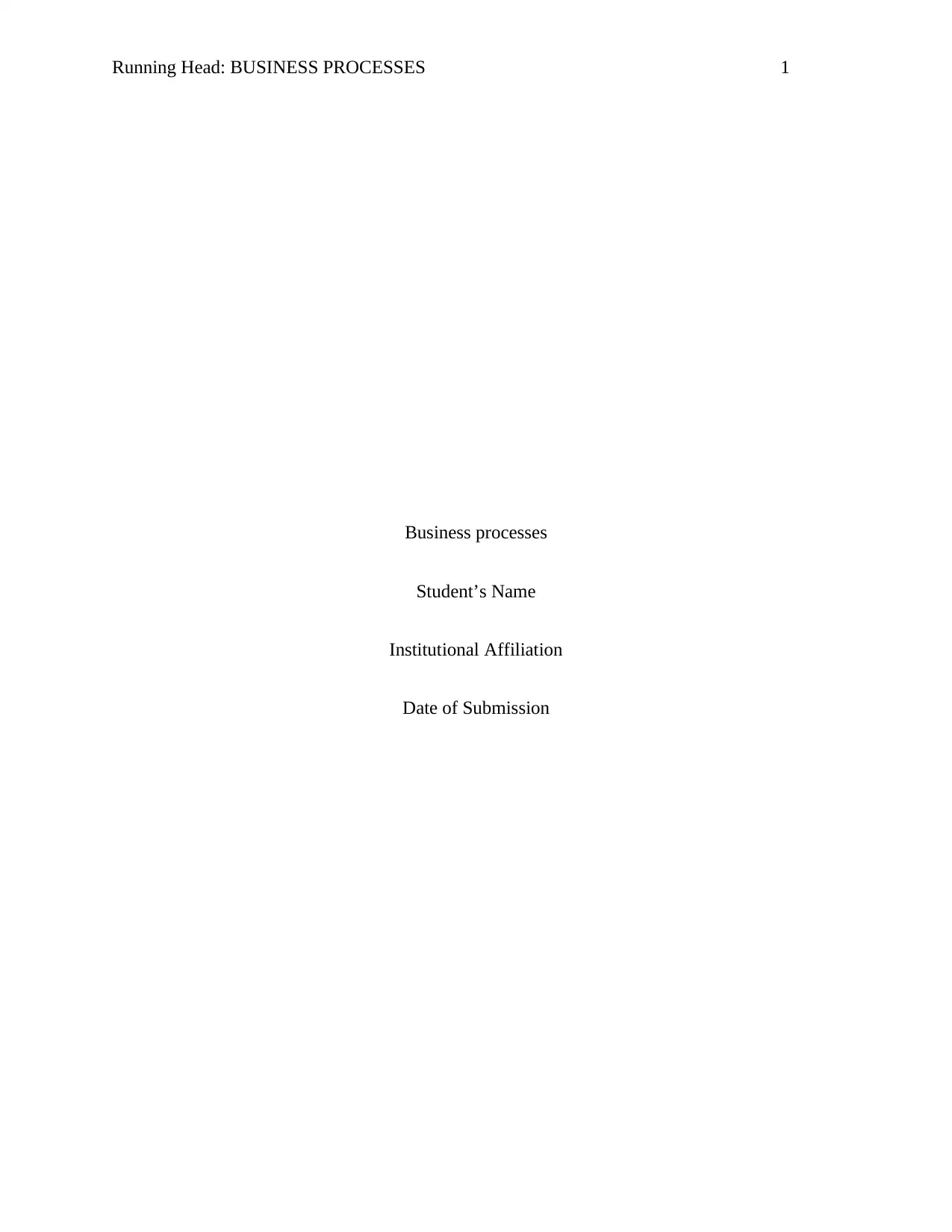
Running Head: BUSINESS PROCESSES 1
Business processes
Student’s Name
Institutional Affiliation
Date of Submission
Business processes
Student’s Name
Institutional Affiliation
Date of Submission
Paraphrase This Document
Need a fresh take? Get an instant paraphrase of this document with our AI Paraphraser
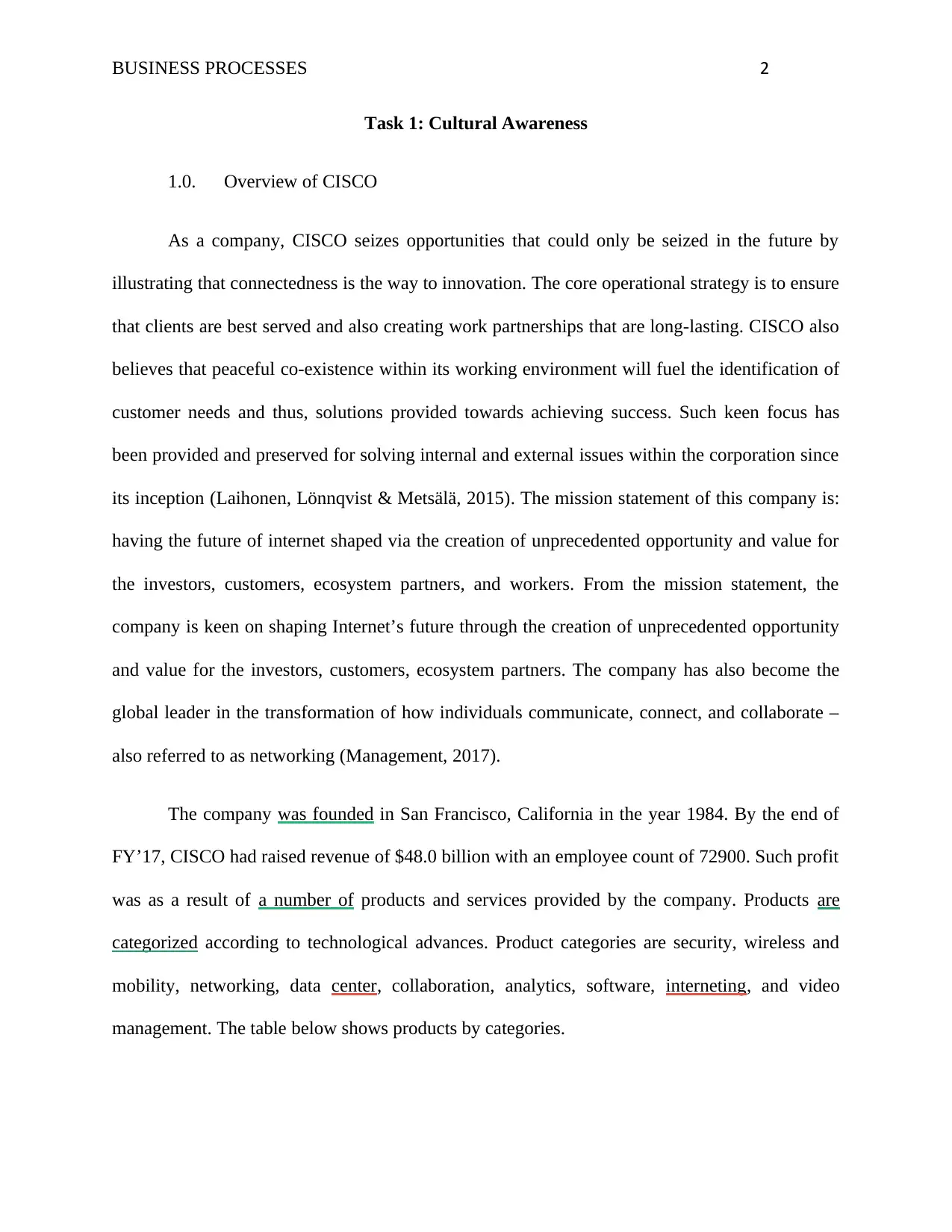
BUSINESS PROCESSES 2
Task 1: Cultural Awareness
1.0. Overview of CISCO
As a company, CISCO seizes opportunities that could only be seized in the future by
illustrating that connectedness is the way to innovation. The core operational strategy is to ensure
that clients are best served and also creating work partnerships that are long-lasting. CISCO also
believes that peaceful co-existence within its working environment will fuel the identification of
customer needs and thus, solutions provided towards achieving success. Such keen focus has
been provided and preserved for solving internal and external issues within the corporation since
its inception (Laihonen, Lönnqvist & Metsälä, 2015). The mission statement of this company is:
having the future of internet shaped via the creation of unprecedented opportunity and value for
the investors, customers, ecosystem partners, and workers. From the mission statement, the
company is keen on shaping Internet’s future through the creation of unprecedented opportunity
and value for the investors, customers, ecosystem partners. The company has also become the
global leader in the transformation of how individuals communicate, connect, and collaborate –
also referred to as networking (Management, 2017).
The company was founded in San Francisco, California in the year 1984. By the end of
FY’17, CISCO had raised revenue of $48.0 billion with an employee count of 72900. Such profit
was as a result of a number of products and services provided by the company. Products are
categorized according to technological advances. Product categories are security, wireless and
mobility, networking, data center, collaboration, analytics, software, interneting, and video
management. The table below shows products by categories.
Task 1: Cultural Awareness
1.0. Overview of CISCO
As a company, CISCO seizes opportunities that could only be seized in the future by
illustrating that connectedness is the way to innovation. The core operational strategy is to ensure
that clients are best served and also creating work partnerships that are long-lasting. CISCO also
believes that peaceful co-existence within its working environment will fuel the identification of
customer needs and thus, solutions provided towards achieving success. Such keen focus has
been provided and preserved for solving internal and external issues within the corporation since
its inception (Laihonen, Lönnqvist & Metsälä, 2015). The mission statement of this company is:
having the future of internet shaped via the creation of unprecedented opportunity and value for
the investors, customers, ecosystem partners, and workers. From the mission statement, the
company is keen on shaping Internet’s future through the creation of unprecedented opportunity
and value for the investors, customers, ecosystem partners. The company has also become the
global leader in the transformation of how individuals communicate, connect, and collaborate –
also referred to as networking (Management, 2017).
The company was founded in San Francisco, California in the year 1984. By the end of
FY’17, CISCO had raised revenue of $48.0 billion with an employee count of 72900. Such profit
was as a result of a number of products and services provided by the company. Products are
categorized according to technological advances. Product categories are security, wireless and
mobility, networking, data center, collaboration, analytics, software, interneting, and video
management. The table below shows products by categories.
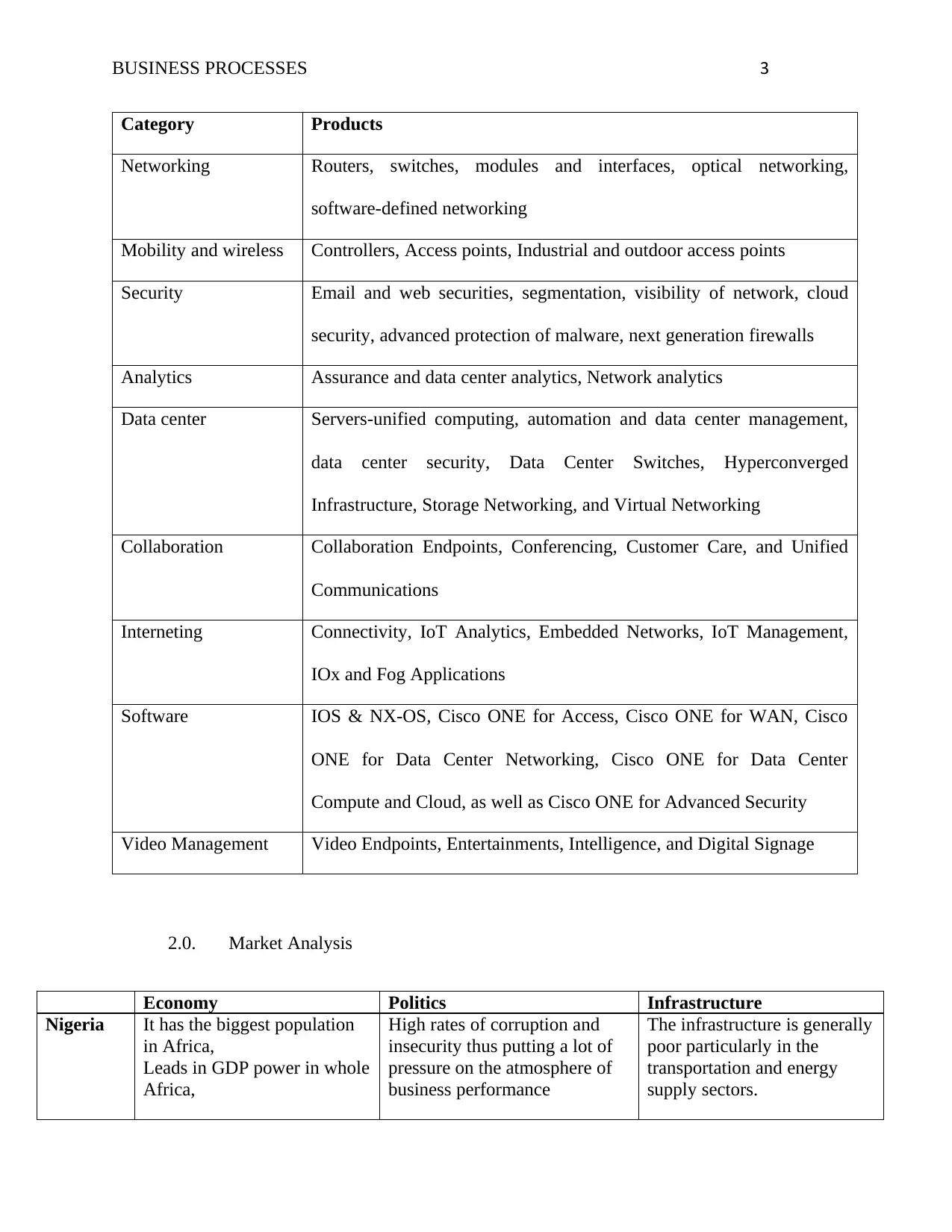
BUSINESS PROCESSES 3
Category Products
Networking Routers, switches, modules and interfaces, optical networking,
software-defined networking
Mobility and wireless Controllers, Access points, Industrial and outdoor access points
Security Email and web securities, segmentation, visibility of network, cloud
security, advanced protection of malware, next generation firewalls
Analytics Assurance and data center analytics, Network analytics
Data center Servers-unified computing, automation and data center management,
data center security, Data Center Switches, Hyperconverged
Infrastructure, Storage Networking, and Virtual Networking
Collaboration Collaboration Endpoints, Conferencing, Customer Care, and Unified
Communications
Interneting Connectivity, IoT Analytics, Embedded Networks, IoT Management,
IOx and Fog Applications
Software IOS & NX-OS, Cisco ONE for Access, Cisco ONE for WAN, Cisco
ONE for Data Center Networking, Cisco ONE for Data Center
Compute and Cloud, as well as Cisco ONE for Advanced Security
Video Management Video Endpoints, Entertainments, Intelligence, and Digital Signage
2.0. Market Analysis
Economy Politics Infrastructure
Nigeria It has the biggest population
in Africa,
Leads in GDP power in whole
Africa,
High rates of corruption and
insecurity thus putting a lot of
pressure on the atmosphere of
business performance
The infrastructure is generally
poor particularly in the
transportation and energy
supply sectors.
Category Products
Networking Routers, switches, modules and interfaces, optical networking,
software-defined networking
Mobility and wireless Controllers, Access points, Industrial and outdoor access points
Security Email and web securities, segmentation, visibility of network, cloud
security, advanced protection of malware, next generation firewalls
Analytics Assurance and data center analytics, Network analytics
Data center Servers-unified computing, automation and data center management,
data center security, Data Center Switches, Hyperconverged
Infrastructure, Storage Networking, and Virtual Networking
Collaboration Collaboration Endpoints, Conferencing, Customer Care, and Unified
Communications
Interneting Connectivity, IoT Analytics, Embedded Networks, IoT Management,
IOx and Fog Applications
Software IOS & NX-OS, Cisco ONE for Access, Cisco ONE for WAN, Cisco
ONE for Data Center Networking, Cisco ONE for Data Center
Compute and Cloud, as well as Cisco ONE for Advanced Security
Video Management Video Endpoints, Entertainments, Intelligence, and Digital Signage
2.0. Market Analysis
Economy Politics Infrastructure
Nigeria It has the biggest population
in Africa,
Leads in GDP power in whole
Africa,
High rates of corruption and
insecurity thus putting a lot of
pressure on the atmosphere of
business performance
The infrastructure is generally
poor particularly in the
transportation and energy
supply sectors.
⊘ This is a preview!⊘
Do you want full access?
Subscribe today to unlock all pages.

Trusted by 1+ million students worldwide
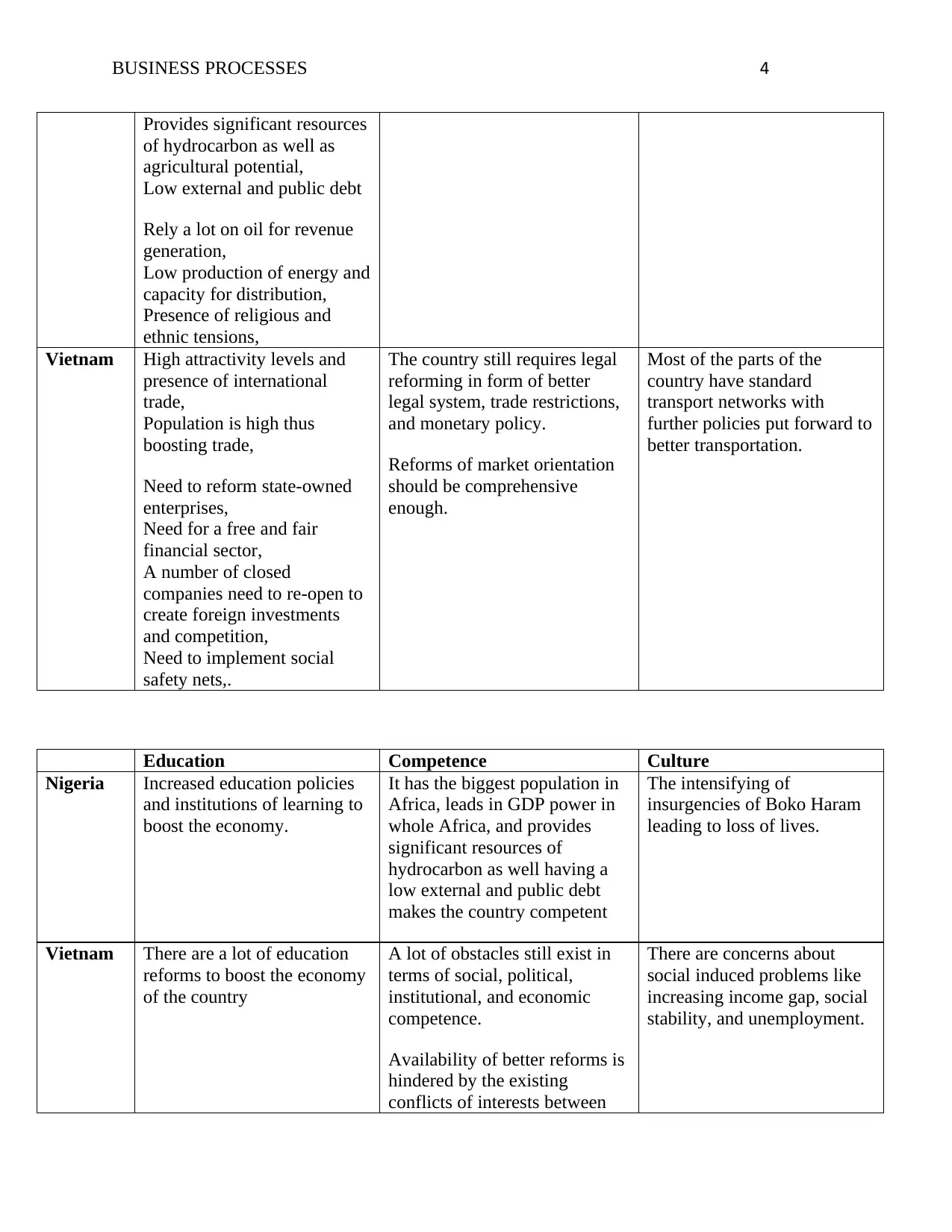
BUSINESS PROCESSES 4
Provides significant resources
of hydrocarbon as well as
agricultural potential,
Low external and public debt
Rely a lot on oil for revenue
generation,
Low production of energy and
capacity for distribution,
Presence of religious and
ethnic tensions,
Vietnam High attractivity levels and
presence of international
trade,
Population is high thus
boosting trade,
Need to reform state-owned
enterprises,
Need for a free and fair
financial sector,
A number of closed
companies need to re-open to
create foreign investments
and competition,
Need to implement social
safety nets,.
The country still requires legal
reforming in form of better
legal system, trade restrictions,
and monetary policy.
Reforms of market orientation
should be comprehensive
enough.
Most of the parts of the
country have standard
transport networks with
further policies put forward to
better transportation.
Education Competence Culture
Nigeria Increased education policies
and institutions of learning to
boost the economy.
It has the biggest population in
Africa, leads in GDP power in
whole Africa, and provides
significant resources of
hydrocarbon as well having a
low external and public debt
makes the country competent
The intensifying of
insurgencies of Boko Haram
leading to loss of lives.
Vietnam There are a lot of education
reforms to boost the economy
of the country
A lot of obstacles still exist in
terms of social, political,
institutional, and economic
competence.
Availability of better reforms is
hindered by the existing
conflicts of interests between
There are concerns about
social induced problems like
increasing income gap, social
stability, and unemployment.
Provides significant resources
of hydrocarbon as well as
agricultural potential,
Low external and public debt
Rely a lot on oil for revenue
generation,
Low production of energy and
capacity for distribution,
Presence of religious and
ethnic tensions,
Vietnam High attractivity levels and
presence of international
trade,
Population is high thus
boosting trade,
Need to reform state-owned
enterprises,
Need for a free and fair
financial sector,
A number of closed
companies need to re-open to
create foreign investments
and competition,
Need to implement social
safety nets,.
The country still requires legal
reforming in form of better
legal system, trade restrictions,
and monetary policy.
Reforms of market orientation
should be comprehensive
enough.
Most of the parts of the
country have standard
transport networks with
further policies put forward to
better transportation.
Education Competence Culture
Nigeria Increased education policies
and institutions of learning to
boost the economy.
It has the biggest population in
Africa, leads in GDP power in
whole Africa, and provides
significant resources of
hydrocarbon as well having a
low external and public debt
makes the country competent
The intensifying of
insurgencies of Boko Haram
leading to loss of lives.
Vietnam There are a lot of education
reforms to boost the economy
of the country
A lot of obstacles still exist in
terms of social, political,
institutional, and economic
competence.
Availability of better reforms is
hindered by the existing
conflicts of interests between
There are concerns about
social induced problems like
increasing income gap, social
stability, and unemployment.
Paraphrase This Document
Need a fresh take? Get an instant paraphrase of this document with our AI Paraphraser
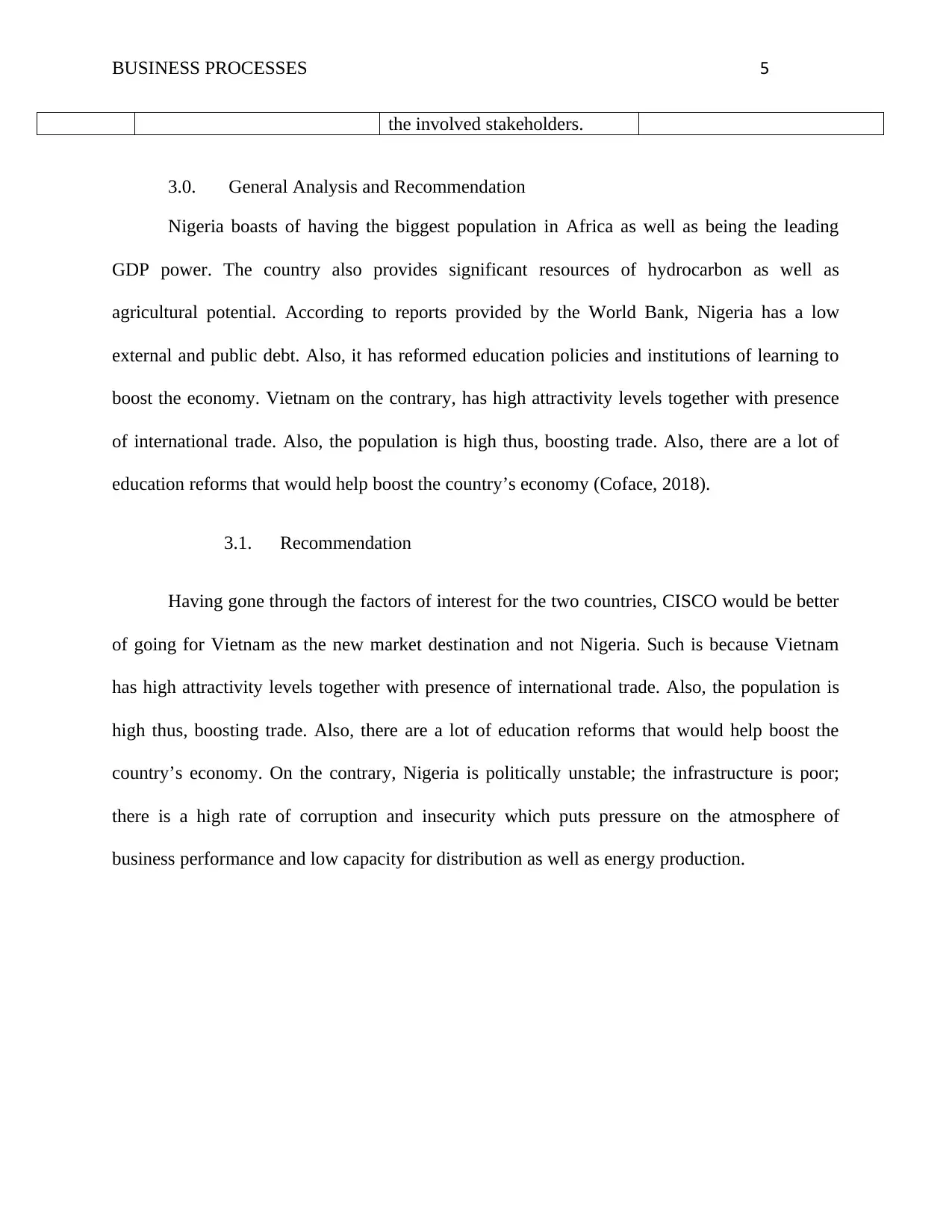
BUSINESS PROCESSES 5
the involved stakeholders.
3.0. General Analysis and Recommendation
Nigeria boasts of having the biggest population in Africa as well as being the leading
GDP power. The country also provides significant resources of hydrocarbon as well as
agricultural potential. According to reports provided by the World Bank, Nigeria has a low
external and public debt. Also, it has reformed education policies and institutions of learning to
boost the economy. Vietnam on the contrary, has high attractivity levels together with presence
of international trade. Also, the population is high thus, boosting trade. Also, there are a lot of
education reforms that would help boost the country’s economy (Coface, 2018).
3.1. Recommendation
Having gone through the factors of interest for the two countries, CISCO would be better
of going for Vietnam as the new market destination and not Nigeria. Such is because Vietnam
has high attractivity levels together with presence of international trade. Also, the population is
high thus, boosting trade. Also, there are a lot of education reforms that would help boost the
country’s economy. On the contrary, Nigeria is politically unstable; the infrastructure is poor;
there is a high rate of corruption and insecurity which puts pressure on the atmosphere of
business performance and low capacity for distribution as well as energy production.
the involved stakeholders.
3.0. General Analysis and Recommendation
Nigeria boasts of having the biggest population in Africa as well as being the leading
GDP power. The country also provides significant resources of hydrocarbon as well as
agricultural potential. According to reports provided by the World Bank, Nigeria has a low
external and public debt. Also, it has reformed education policies and institutions of learning to
boost the economy. Vietnam on the contrary, has high attractivity levels together with presence
of international trade. Also, the population is high thus, boosting trade. Also, there are a lot of
education reforms that would help boost the country’s economy (Coface, 2018).
3.1. Recommendation
Having gone through the factors of interest for the two countries, CISCO would be better
of going for Vietnam as the new market destination and not Nigeria. Such is because Vietnam
has high attractivity levels together with presence of international trade. Also, the population is
high thus, boosting trade. Also, there are a lot of education reforms that would help boost the
country’s economy. On the contrary, Nigeria is politically unstable; the infrastructure is poor;
there is a high rate of corruption and insecurity which puts pressure on the atmosphere of
business performance and low capacity for distribution as well as energy production.
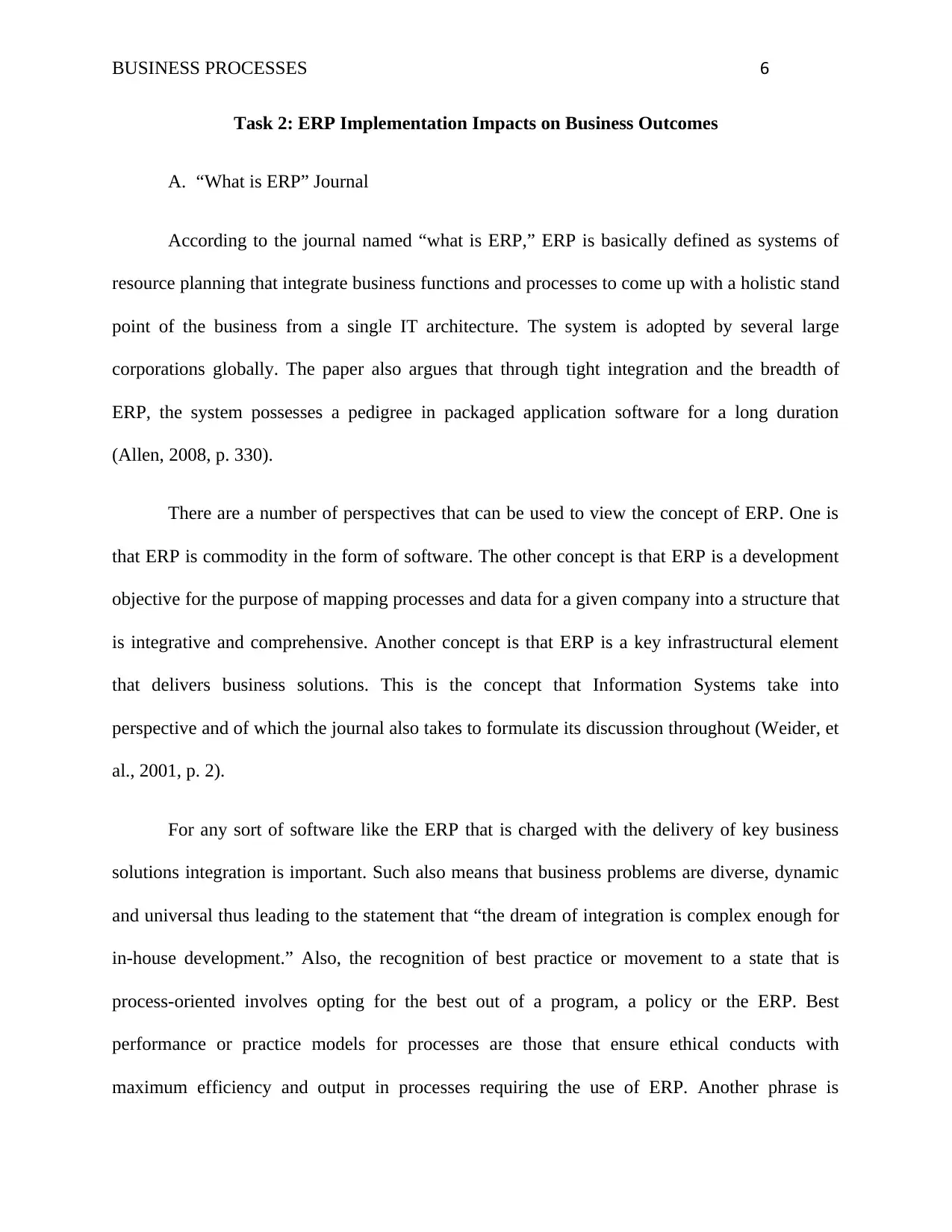
BUSINESS PROCESSES 6
Task 2: ERP Implementation Impacts on Business Outcomes
A. “What is ERP” Journal
According to the journal named “what is ERP,” ERP is basically defined as systems of
resource planning that integrate business functions and processes to come up with a holistic stand
point of the business from a single IT architecture. The system is adopted by several large
corporations globally. The paper also argues that through tight integration and the breadth of
ERP, the system possesses a pedigree in packaged application software for a long duration
(Allen, 2008, p. 330).
There are a number of perspectives that can be used to view the concept of ERP. One is
that ERP is commodity in the form of software. The other concept is that ERP is a development
objective for the purpose of mapping processes and data for a given company into a structure that
is integrative and comprehensive. Another concept is that ERP is a key infrastructural element
that delivers business solutions. This is the concept that Information Systems take into
perspective and of which the journal also takes to formulate its discussion throughout (Weider, et
al., 2001, p. 2).
For any sort of software like the ERP that is charged with the delivery of key business
solutions integration is important. Such also means that business problems are diverse, dynamic
and universal thus leading to the statement that “the dream of integration is complex enough for
in-house development.” Also, the recognition of best practice or movement to a state that is
process-oriented involves opting for the best out of a program, a policy or the ERP. Best
performance or practice models for processes are those that ensure ethical conducts with
maximum efficiency and output in processes requiring the use of ERP. Another phrase is
Task 2: ERP Implementation Impacts on Business Outcomes
A. “What is ERP” Journal
According to the journal named “what is ERP,” ERP is basically defined as systems of
resource planning that integrate business functions and processes to come up with a holistic stand
point of the business from a single IT architecture. The system is adopted by several large
corporations globally. The paper also argues that through tight integration and the breadth of
ERP, the system possesses a pedigree in packaged application software for a long duration
(Allen, 2008, p. 330).
There are a number of perspectives that can be used to view the concept of ERP. One is
that ERP is commodity in the form of software. The other concept is that ERP is a development
objective for the purpose of mapping processes and data for a given company into a structure that
is integrative and comprehensive. Another concept is that ERP is a key infrastructural element
that delivers business solutions. This is the concept that Information Systems take into
perspective and of which the journal also takes to formulate its discussion throughout (Weider, et
al., 2001, p. 2).
For any sort of software like the ERP that is charged with the delivery of key business
solutions integration is important. Such also means that business problems are diverse, dynamic
and universal thus leading to the statement that “the dream of integration is complex enough for
in-house development.” Also, the recognition of best practice or movement to a state that is
process-oriented involves opting for the best out of a program, a policy or the ERP. Best
performance or practice models for processes are those that ensure ethical conducts with
maximum efficiency and output in processes requiring the use of ERP. Another phrase is
⊘ This is a preview!⊘
Do you want full access?
Subscribe today to unlock all pages.

Trusted by 1+ million students worldwide
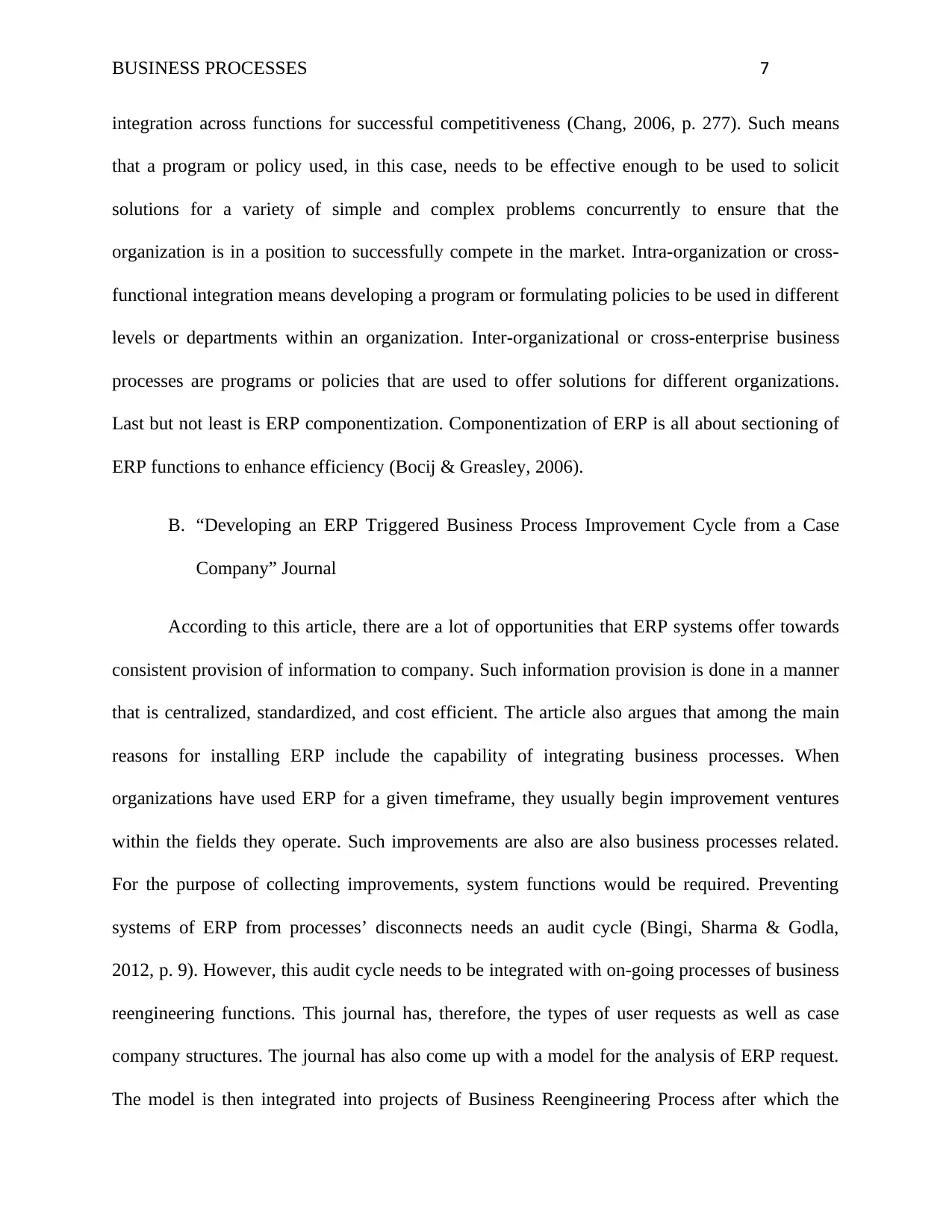
BUSINESS PROCESSES 7
integration across functions for successful competitiveness (Chang, 2006, p. 277). Such means
that a program or policy used, in this case, needs to be effective enough to be used to solicit
solutions for a variety of simple and complex problems concurrently to ensure that the
organization is in a position to successfully compete in the market. Intra-organization or cross-
functional integration means developing a program or formulating policies to be used in different
levels or departments within an organization. Inter-organizational or cross-enterprise business
processes are programs or policies that are used to offer solutions for different organizations.
Last but not least is ERP componentization. Componentization of ERP is all about sectioning of
ERP functions to enhance efficiency (Bocij & Greasley, 2006).
B. “Developing an ERP Triggered Business Process Improvement Cycle from a Case
Company” Journal
According to this article, there are a lot of opportunities that ERP systems offer towards
consistent provision of information to company. Such information provision is done in a manner
that is centralized, standardized, and cost efficient. The article also argues that among the main
reasons for installing ERP include the capability of integrating business processes. When
organizations have used ERP for a given timeframe, they usually begin improvement ventures
within the fields they operate. Such improvements are also are also business processes related.
For the purpose of collecting improvements, system functions would be required. Preventing
systems of ERP from processes’ disconnects needs an audit cycle (Bingi, Sharma & Godla,
2012, p. 9). However, this audit cycle needs to be integrated with on-going processes of business
reengineering functions. This journal has, therefore, the types of user requests as well as case
company structures. The journal has also come up with a model for the analysis of ERP request.
The model is then integrated into projects of Business Reengineering Process after which the
integration across functions for successful competitiveness (Chang, 2006, p. 277). Such means
that a program or policy used, in this case, needs to be effective enough to be used to solicit
solutions for a variety of simple and complex problems concurrently to ensure that the
organization is in a position to successfully compete in the market. Intra-organization or cross-
functional integration means developing a program or formulating policies to be used in different
levels or departments within an organization. Inter-organizational or cross-enterprise business
processes are programs or policies that are used to offer solutions for different organizations.
Last but not least is ERP componentization. Componentization of ERP is all about sectioning of
ERP functions to enhance efficiency (Bocij & Greasley, 2006).
B. “Developing an ERP Triggered Business Process Improvement Cycle from a Case
Company” Journal
According to this article, there are a lot of opportunities that ERP systems offer towards
consistent provision of information to company. Such information provision is done in a manner
that is centralized, standardized, and cost efficient. The article also argues that among the main
reasons for installing ERP include the capability of integrating business processes. When
organizations have used ERP for a given timeframe, they usually begin improvement ventures
within the fields they operate. Such improvements are also are also business processes related.
For the purpose of collecting improvements, system functions would be required. Preventing
systems of ERP from processes’ disconnects needs an audit cycle (Bingi, Sharma & Godla,
2012, p. 9). However, this audit cycle needs to be integrated with on-going processes of business
reengineering functions. This journal has, therefore, the types of user requests as well as case
company structures. The journal has also come up with a model for the analysis of ERP request.
The model is then integrated into projects of Business Reengineering Process after which the
Paraphrase This Document
Need a fresh take? Get an instant paraphrase of this document with our AI Paraphraser
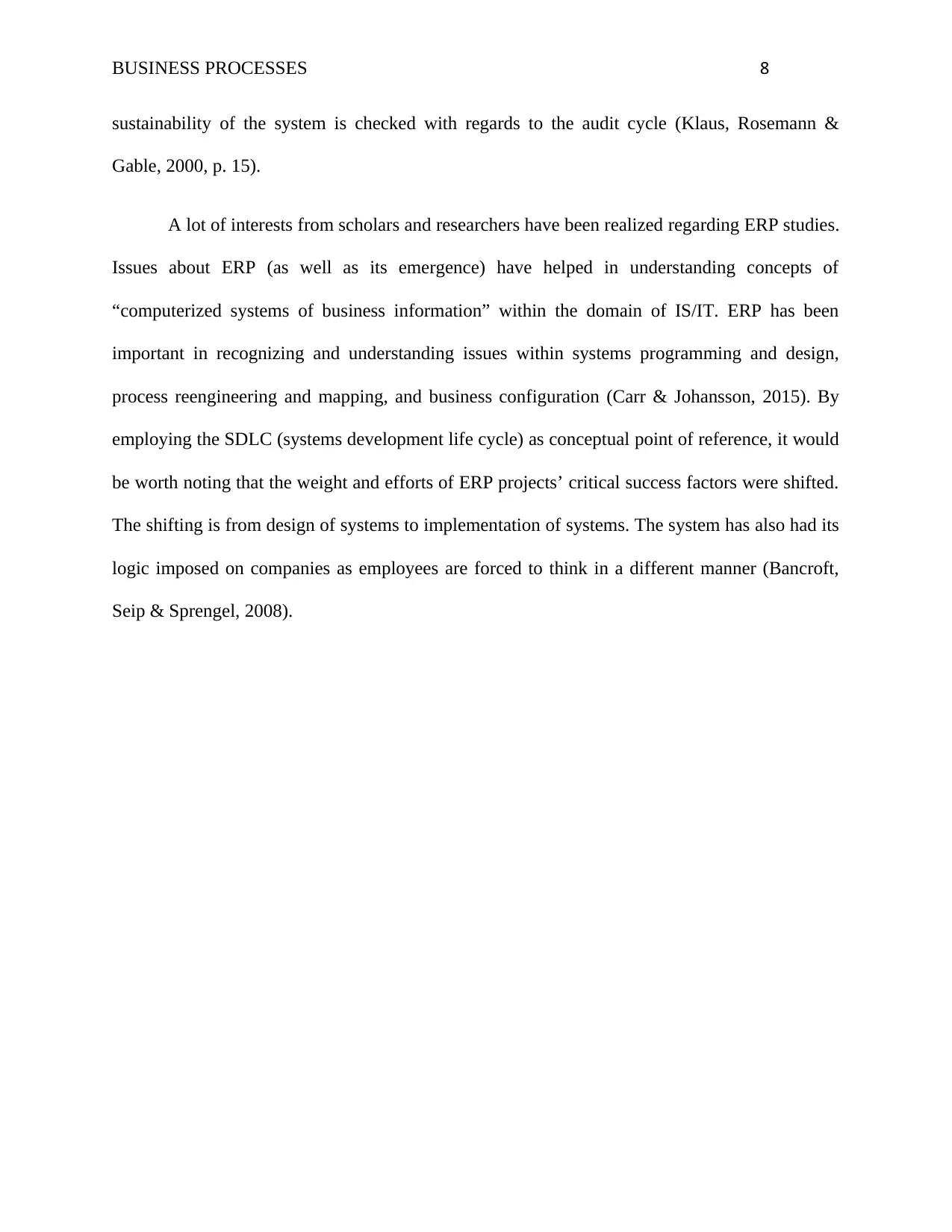
BUSINESS PROCESSES 8
sustainability of the system is checked with regards to the audit cycle (Klaus, Rosemann &
Gable, 2000, p. 15).
A lot of interests from scholars and researchers have been realized regarding ERP studies.
Issues about ERP (as well as its emergence) have helped in understanding concepts of
“computerized systems of business information” within the domain of IS/IT. ERP has been
important in recognizing and understanding issues within systems programming and design,
process reengineering and mapping, and business configuration (Carr & Johansson, 2015). By
employing the SDLC (systems development life cycle) as conceptual point of reference, it would
be worth noting that the weight and efforts of ERP projects’ critical success factors were shifted.
The shifting is from design of systems to implementation of systems. The system has also had its
logic imposed on companies as employees are forced to think in a different manner (Bancroft,
Seip & Sprengel, 2008).
sustainability of the system is checked with regards to the audit cycle (Klaus, Rosemann &
Gable, 2000, p. 15).
A lot of interests from scholars and researchers have been realized regarding ERP studies.
Issues about ERP (as well as its emergence) have helped in understanding concepts of
“computerized systems of business information” within the domain of IS/IT. ERP has been
important in recognizing and understanding issues within systems programming and design,
process reengineering and mapping, and business configuration (Carr & Johansson, 2015). By
employing the SDLC (systems development life cycle) as conceptual point of reference, it would
be worth noting that the weight and efforts of ERP projects’ critical success factors were shifted.
The shifting is from design of systems to implementation of systems. The system has also had its
logic imposed on companies as employees are forced to think in a different manner (Bancroft,
Seip & Sprengel, 2008).
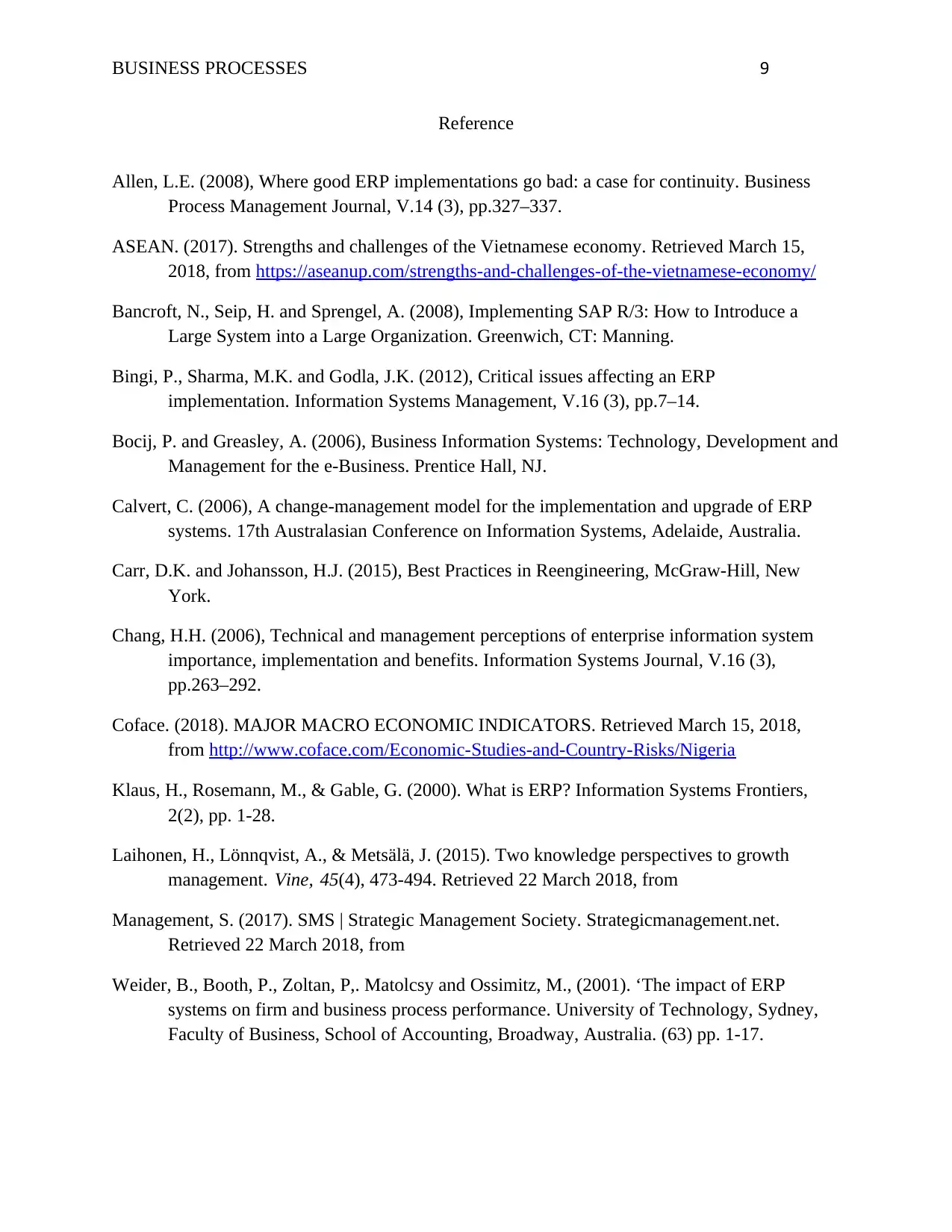
BUSINESS PROCESSES 9
Reference
Allen, L.E. (2008), Where good ERP implementations go bad: a case for continuity. Business
Process Management Journal, V.14 (3), pp.327–337.
ASEAN. (2017). Strengths and challenges of the Vietnamese economy. Retrieved March 15,
2018, from https://aseanup.com/strengths-and-challenges-of-the-vietnamese-economy/
Bancroft, N., Seip, H. and Sprengel, A. (2008), Implementing SAP R/3: How to Introduce a
Large System into a Large Organization. Greenwich, CT: Manning.
Bingi, P., Sharma, M.K. and Godla, J.K. (2012), Critical issues affecting an ERP
implementation. Information Systems Management, V.16 (3), pp.7–14.
Bocij, P. and Greasley, A. (2006), Business Information Systems: Technology, Development and
Management for the e-Business. Prentice Hall, NJ.
Calvert, C. (2006), A change-management model for the implementation and upgrade of ERP
systems. 17th Australasian Conference on Information Systems, Adelaide, Australia.
Carr, D.K. and Johansson, H.J. (2015), Best Practices in Reengineering, McGraw-Hill, New
York.
Chang, H.H. (2006), Technical and management perceptions of enterprise information system
importance, implementation and benefits. Information Systems Journal, V.16 (3),
pp.263–292.
Coface. (2018). MAJOR MACRO ECONOMIC INDICATORS. Retrieved March 15, 2018,
from http://www.coface.com/Economic-Studies-and-Country-Risks/Nigeria
Klaus, H., Rosemann, M., & Gable, G. (2000). What is ERP? Information Systems Frontiers,
2(2), pp. 1-28.
Laihonen, H., Lönnqvist, A., & Metsälä, J. (2015). Two knowledge perspectives to growth
management. Vine, 45(4), 473-494. Retrieved 22 March 2018, from
Management, S. (2017). SMS | Strategic Management Society. Strategicmanagement.net.
Retrieved 22 March 2018, from
Weider, B., Booth, P., Zoltan, P,. Matolcsy and Ossimitz, M., (2001). ‘The impact of ERP
systems on firm and business process performance. University of Technology, Sydney,
Faculty of Business, School of Accounting, Broadway, Australia. (63) pp. 1-17.
Reference
Allen, L.E. (2008), Where good ERP implementations go bad: a case for continuity. Business
Process Management Journal, V.14 (3), pp.327–337.
ASEAN. (2017). Strengths and challenges of the Vietnamese economy. Retrieved March 15,
2018, from https://aseanup.com/strengths-and-challenges-of-the-vietnamese-economy/
Bancroft, N., Seip, H. and Sprengel, A. (2008), Implementing SAP R/3: How to Introduce a
Large System into a Large Organization. Greenwich, CT: Manning.
Bingi, P., Sharma, M.K. and Godla, J.K. (2012), Critical issues affecting an ERP
implementation. Information Systems Management, V.16 (3), pp.7–14.
Bocij, P. and Greasley, A. (2006), Business Information Systems: Technology, Development and
Management for the e-Business. Prentice Hall, NJ.
Calvert, C. (2006), A change-management model for the implementation and upgrade of ERP
systems. 17th Australasian Conference on Information Systems, Adelaide, Australia.
Carr, D.K. and Johansson, H.J. (2015), Best Practices in Reengineering, McGraw-Hill, New
York.
Chang, H.H. (2006), Technical and management perceptions of enterprise information system
importance, implementation and benefits. Information Systems Journal, V.16 (3),
pp.263–292.
Coface. (2018). MAJOR MACRO ECONOMIC INDICATORS. Retrieved March 15, 2018,
from http://www.coface.com/Economic-Studies-and-Country-Risks/Nigeria
Klaus, H., Rosemann, M., & Gable, G. (2000). What is ERP? Information Systems Frontiers,
2(2), pp. 1-28.
Laihonen, H., Lönnqvist, A., & Metsälä, J. (2015). Two knowledge perspectives to growth
management. Vine, 45(4), 473-494. Retrieved 22 March 2018, from
Management, S. (2017). SMS | Strategic Management Society. Strategicmanagement.net.
Retrieved 22 March 2018, from
Weider, B., Booth, P., Zoltan, P,. Matolcsy and Ossimitz, M., (2001). ‘The impact of ERP
systems on firm and business process performance. University of Technology, Sydney,
Faculty of Business, School of Accounting, Broadway, Australia. (63) pp. 1-17.
⊘ This is a preview!⊘
Do you want full access?
Subscribe today to unlock all pages.

Trusted by 1+ million students worldwide
1 out of 9
Related Documents
Your All-in-One AI-Powered Toolkit for Academic Success.
+13062052269
info@desklib.com
Available 24*7 on WhatsApp / Email
![[object Object]](/_next/static/media/star-bottom.7253800d.svg)
Unlock your academic potential
Copyright © 2020–2025 A2Z Services. All Rights Reserved. Developed and managed by ZUCOL.




